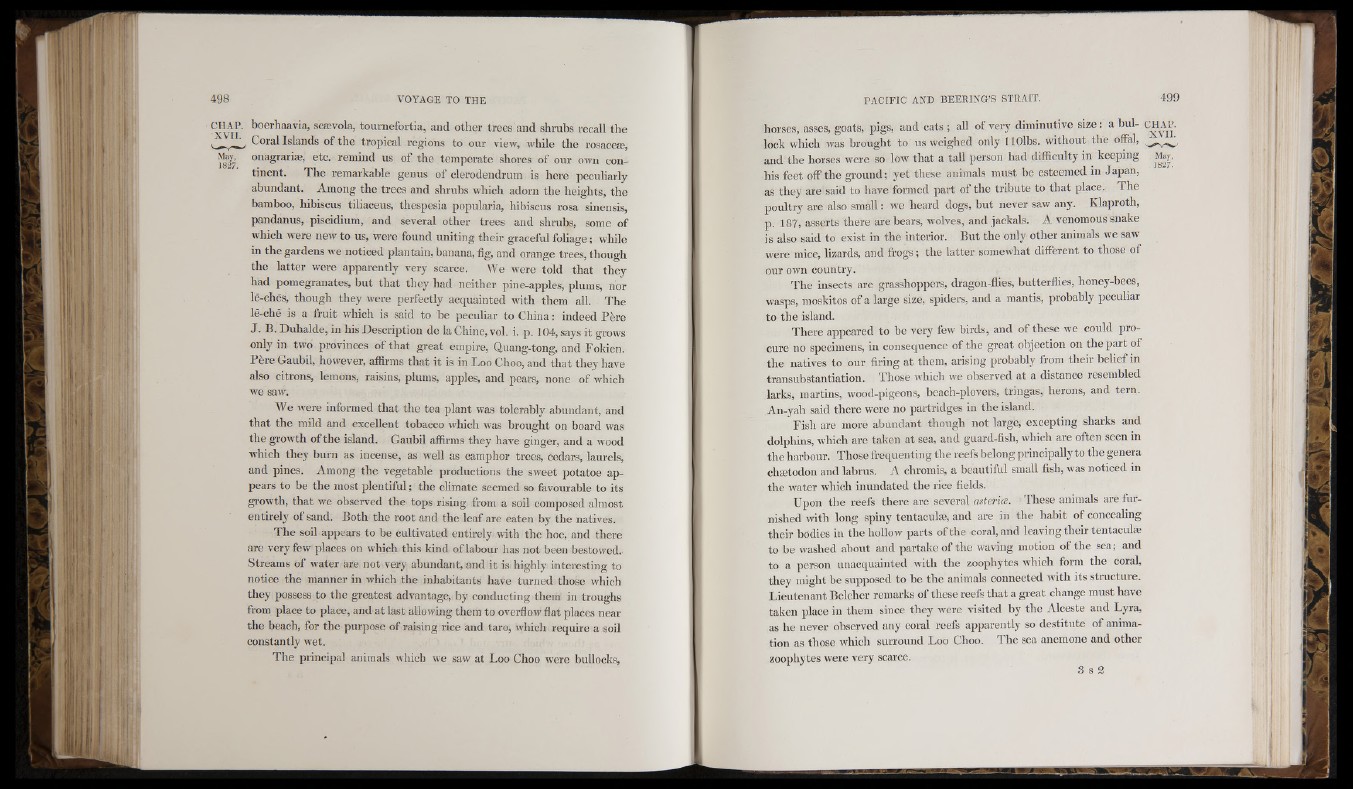
T,r
t
li i . I
Mí
lí-íií
ll i ill
Il t í
I > '
‘niL :
iMl
111
C H A P . boerhaavi,-!, seævola, tournofortia, and other trees and shrubs recall the
May,
1827.
, Coral Islands of the tropical regions to our view, while the rosaceæ,
onagrariæ, etc. remind us of the temperate shores of our own continent.
The remarkable genus of clerodendrum is here peculiarly
abundant. Among the trees and shrubs which adorn the heights, the
bamboo, hibiscus tiliaceus, thespesia popularía, hibiscus rosa sinensis,
pandanus, piscidium, and several other trees and shrubs, some of
which were new to us, were found uniting their graceful foliage ; while
in the gardens we noticed plantain, banana, fig, and orange trees, though
the latter were apparently very scarce. We were told that they
had pomegranates, but that they had neither pine-apples, plums, nor
lé-chës, though they were perfectly acquainted with them all. The
lê-ché is a fruit which is said to be peculiar to China : indeed Père
J. B. Duhalde, in his Description de la Chine, vol. i. p. 104, says it grows
only in two provinces of that great empire, Quang-tong, and Fokien.
Père Gaubil, however, affirms that it is in Loo Choo, and that they have
also citrons, lemons, raisins, plums, apples, and pears, none of which
we saw.
We were informed that the tea plant was tolerably abundant, and
that the mild and excellent tobacco which was brought on board was
the growth of the island. Gaubil affirms they have ginger, and a wood
which they burn as incense, as well as camphor trees, cedars, laurels,
and pines. Among the vegetable productions the sweet potatoe appears
to be the most plentiful ; the climate seemed so favourable to its
growth, that we observed the tops rising from a soil composed almost
entirely of sand. Both the root and the leaf are eaten by the natives.
The soil appears to be cultivated entirely with the hoe, and there
are very few places on which this kind oflabour has not been bestowed.
Streams of water are not very abundant, and it is highly interesting to
notice the manner in which the inhabitants have turned those which
they possess to the greatest advantage, by conducting them in troughs
from place to place, and at last allowing them to overflow flat places near
the beach, for the jmrpose of raising rice and taro, which require a soil
constantly wet.
The principal animals which we saw at Loo Choo were bullocks,
horses, asses, goats, pigs, and cats ; all of very diminutive size ; a bui- C H X l \
lock which was brought to us weighed only llOlbs. without the offal,
and the horses were so low that a tall person had difficulty in keeping
his feet offthe ground; yet these animals must be esteemed in Japan,
as they are said to have formed part of the tribute to that place. The
poultry are also small ; we heard dogs, but never saw any. Klaproth,
p. 187, asserts there are bears, wolves, and jackals. A venomous snake
is also said to exist in the interior. But the only other animals we saw
were mice, lizards, and frogs ; the latter somewhat different to those of
our own country.
The insects are grasshoppers, dragon-flies, butterflies, honey-bees,
w'asps, moskitos of a large size, spiders, and a mantis, probably peculiar
to the island.
There appeared to be very few birds, and of these we could procure
no specimens, in consequence of the great objection on the part of
the natives to our firing at them, arising probably from their belief in
transubstantiation. Those which we observed at a distance resembled
larks, martins, wood-pigeons, beach-plovers, tringas, herons, and tern.
An-yah said there were no partridges in the island.
Fish are more abundant though not large, excepting sharks and
dolphins, which are taken at sea, and guard-fish, which are often seen in
the harbour. Those frequenting the reefs belong principally to the genera
chætodon and labrus. A chromis, a beautiful small fish, was noticed in
the water which inundated the rice fields.
Upon tlie reefs there are several asterue. These animals are furnished
with long spiny tentaculæ, and are in the habit of concealing
their bodies in the hollow parts of the coral, and leaving their tentaculæ
to be washed about and partake of the waving motion of the sea; and
to a person unacquainted w'ith the zoophytes which form the coral,
they might be supposed to be the animals connected with its structure.
Lieutenant Belcher remarks of these reefs that a great change must have
taken place in them since they wxre visited by the Alceste and Lyra,
as he never observed any coral reefs apparently so destitute of animation
as those which surround Loo Choo. The sea anemone and other
zoophytes were very scarce.
S s 2
Mav,
1827-